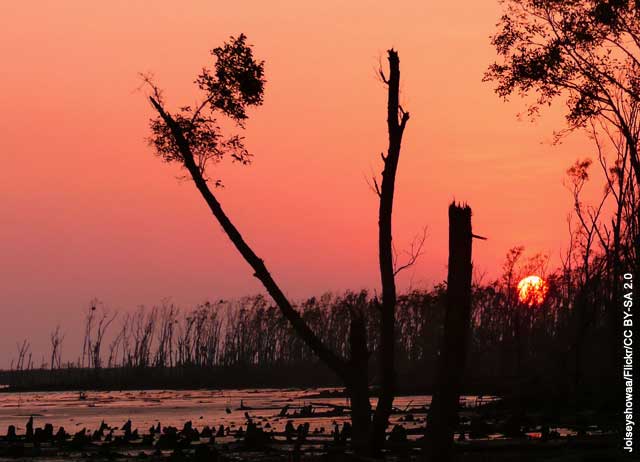22 Aug 2013
UNEP Environmental Alert: Global Mangrove Forest Cover Fading Fast
Nairobi, Aug 2013 – The uniquely adapted mangrove forests on the marine-terrestrial interface preserve coastline integrity by buffering wave energy from marine processes. The ecosystem services they provide and their support for coastal livelihoods worldwide are worth at least US $1.6 billion a year. Despite their global importance, mangroves are being lost rapidly and action is urgently needed to protect them.
|
||||
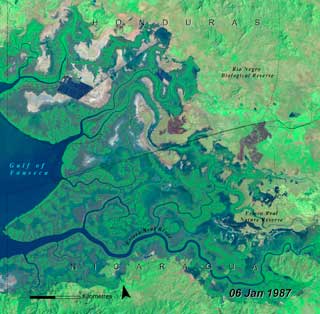
|
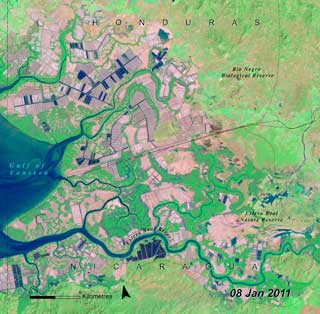
|
| Figure 4: Satellite images showing an increase of shrimp farms in the Gulf of Fonseca, Honduras. The shrimp ponds appear as blue and pink rectangles near the water line scattered across the mangrove delta in the 2011 image, a period of 24 years since 1987. | |
(ii) Global temperature rise:
While mangroves often show resistance and resilience in the face of disturbances, the additional stresses brought by climate change may cause sudden and irreversible losses at many sites (Huxham et al., 2010). Warmer temperatures will increase evaporation rates and salinity in the sediments on the landward fringe of a mangrove forest. This may cause a die-back of mangroves or a reduction in diversity (Huxham et al., 2010).
(iii) Rising sea levels:
The global sea level has already risen 12 to 22 centimetres over the course of the 20th century due to global warming and sea-level rise could be the greatest threat facing the future of mangroves (Gilman et al., 2008). If local conditions restrain mangroves from adapting to rising sea levels through inland migration, they will become increasingly submerged. Even in circumstances in which inland migration could occur as shown in Figure 5, there may still be negative impacts on people, since it is the seaward fringes, and not the inland margins, that provide the most valuable environmental services for fisheries and coastal protection (López-Medellín et al., 2011).
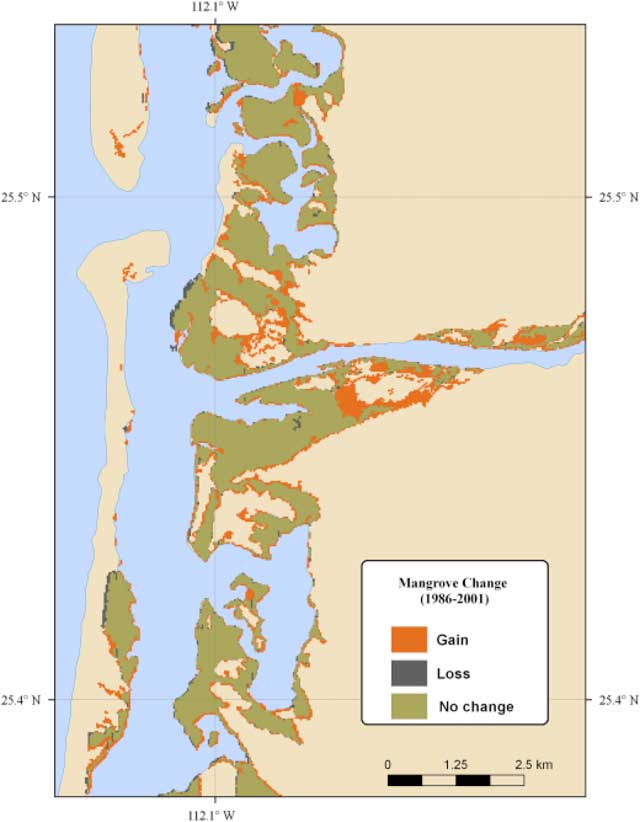 Figure 5: Change in the spectral signature of mangrove canopies from 1986 to 2001, detected in Landsat images near Boca de Santo Domingo, one of the flattest coastal plains in Magdalena Bay, in Baja California, Mexico and one of the areas least disturbed by direct human action. A trend in mangrove reduction is observed in the lagoon’s fringes, while cover tended to increase in the landward edges of the forest where the mangrove forest meets the desert. However, heavy development has occurred in the area since 2001 (López-Medellín et al., 2011).
Figure 5: Change in the spectral signature of mangrove canopies from 1986 to 2001, detected in Landsat images near Boca de Santo Domingo, one of the flattest coastal plains in Magdalena Bay, in Baja California, Mexico and one of the areas least disturbed by direct human action. A trend in mangrove reduction is observed in the lagoon’s fringes, while cover tended to increase in the landward edges of the forest where the mangrove forest meets the desert. However, heavy development has occurred in the area since 2001 (López-Medellín et al., 2011).
(iv) Storms and natural disasters:
High levels of damage may be inflicted on mangroves during storms. A massive loss of mangroves following a hurricane in Honduras led to peat collapse, which reduced recovery rates (Cahoon et al., 2003). Furthermore, mangrove ecosystems can be converted to other types of ecosystems as a consequence of storm impact. For example, mangrove forests in Everglades National Park in Florida have been converted to intertidal mud flats following the impacts of hurricanes Andrew in 1992 and Wilma in 2005 (Smith et al., 2009).
Progress in the conservation and restoration of mangroves
Since the 2004 Indian Ocean tsunami, there has been a general increase in the awareness of the importance of mangrove ecosystems; efforts to conserve, protect and restore them can be seen in Bangladesh, India, Indonesia, Myanmar, Seychelles, Sri Lanka, Pakistan, Thailand and Vietnam (Macintosh et al., 2012). The Ministries of Environment and Natural Resources of Guatemala, Honduras and Nicaragua, in collaboration with the UN Environment Programme, have embarked on sustainable mangrove management, raising awareness of the critical role mangroves play in areas that are constantly threatened by the risk of hurricanes and sea level rise (UNEP, 2012).
What are the implications for policy?
As the negative impacts of climate change, including rising sea levels, become more evident, the economic value of coastal wetlands for protection will also increase as the need for their buffering services becomes more critical (Costanza et al., 2008). While market pressures push for mangroves to be cleared for aquaculture and urbanization, coastal land managers must consider not only the value of the services that mangroves provide, but also their potential value in the future.
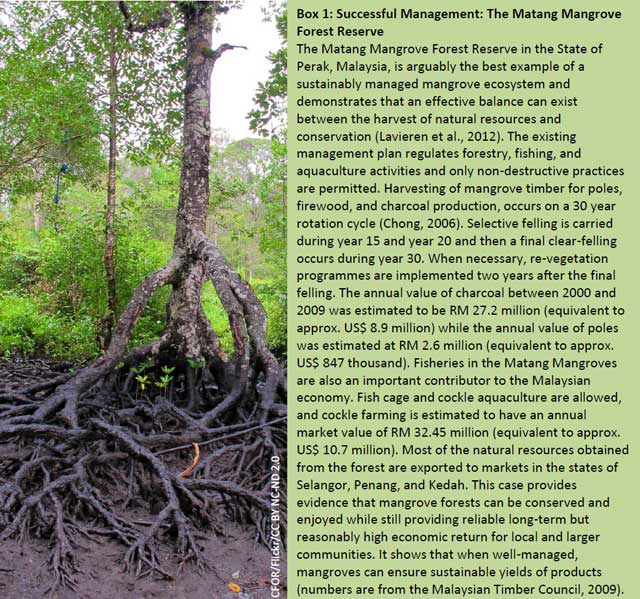
Mangrove conservation and management
Curbing deforestation may be more effective than reforestation. In the last decade, a study in Thailand found that the cost of restoring mangroves was US $946 per hectare, while the cost for protecting existing mangroves was only US $189 per hectare (Ramsar Secretariat, 2001).
Framework policy and legislation established at national levels, and integrated into a broader spatial framework of coastal zone management, should cross all sectors and involve all stakeholders to prevent piecemeal loss and degradation (Lavieren et al., n.d.). For example, countries such as Tanzania and Malaysia have placed all mangroves in forest reserves under state ownership. In some locations in Australia and the United States, local policies of “no net loss” have placed specific limitations on future mangrove clearance. These strategies will be effective in the long term if backed by strong political will, enforcement measures and penalties for noncompliance.
An array of market-oriented strategies have been proposed to curtail the conversion of mangrove areas to other land uses. The fact that mangrove forests are increasingly recognized as a valuable source of revenue should in theory make it easier to entice those who benefit from mangroves to make payments for the ecosystem services that they generate (Lavieren et al., n.d.). Furthermore, because mangrove forests store significant amounts of carbon and are threatened by the economic allure of conversion, they could be ideal targets for carbon financing. Such initiatives and investment funds provide exciting new opportunities to better protect natural capital, benefit communities, and utilize cost-effective green technologies to address the challenges of climate change.
Acknowledgement
Written by: Braedon Cashiona
Production and Outreach Team: Arshia Chanderb, Ashbindu Singhb,c, Erick Litswac, Kim Gieseb, Lindsey Harrimanb, Michelle Anthonyb, Reza Hussainb, Tejaswi Girib, Theuri Mwangic and Zinta Zommersc.
Special thanks to Charles Daviesa, Silvia Giadaa, Andrea Salinasa, Lucia Scodanibbioa, Zinta Zommersc and Pascal Peduzzid for their valuable inputs and Shelley Robertsone for copy editing.
(a UNEP/DEWA-LAC- Panama; b UNEP/GRID-Sioux Falls; c UNEP/DEWA-Nairobi; d UNEP/GRID-Geneva; e Munk School of Global Affairs, University of Toronto)
References
Cahoon, D., Hensel, P., Rybczyk, J., McKee, K., Proffitt, E., Perez, C., 2003. Mass tree mortality leads to mangrove peat collapse at Bay Islands, Honduras after Hurricane Mitch. J. Ecol. 91, 1093–1105.
Chong, V., 2006. Sustainable utilization and management of mangrove ecosystems of Malaysia. Aquatic Ecosystem Health and Management 9, 249-260.
Cornforth, A., Fatoyinbo, E., Freemantle, P., Pettorelli, N., 2013. Advanced Land Observing Satellite Phased Array Type L-Band SAR (ALOS PALSAR) to Inform the Conservation of Mangroves: Sundarbans as a Case Study. Remote Sens. 5, 224-237.
Costanza, R., Pérez-Maqueo, O., Martinez, M., Sutton, P., Anderson, S., Mulder, K., 2008. The value of coastal wetlands for hurricane protection. Ambio. 37(4), 241–248.
Dittmar, T., Hertkorn, N., Kattner, G., Lara, R., 2006. Mangroves, a major source of dissolved organic carbon to the oceans. Global Biogeochem Cycles 20(1), DOI: 10.1029/2005GB002570.
Duke, N., Meynecke, J., Dittmann, S., Ellison, A., Anger. K, U. Berger, Cannicci, S., Diele, K., Ewel, K., Field, C., Koedam, N., Lee, S., Marchand, C., Nordhaus, I., Dahdouh-Guebas, F., 2007. A world without mangroves. Science 317(5834), 41-42.
Ellison, A., 2008. Managing mangroves with benthic biodiversity in mind: moving beyond roving banditry. Journal of Sea Research 59(1-2), 2–15.
Emerton, L., Seilava, R. and Pearith, H., 2002. Bokor, Kirirom, Kep and Ream National Parks, Cambodia: Case studies of economic and development linkages, field study report, in Review of Protected Areas and their Role in the Socio-Economic Development of the Four Countries of the Lower Mekong Region, International Centre for Environmental Management, Brisbane and IUCN Regional Environmental Economics Programme, Karachi. http://cmsdata.iucn.org/downloads/casestudy03ream.pdf (accessed 15.08.13).
FAO, 2007. The World’s Mangroves 1980-2005, FAO Forestry Paper 153. Rome: Forest Resources Division, FAO. The Food and Agriculture Organisation of the United Nations. 77 p.
Gilman, E., Ellison, J., Duke, N. and Field, C., 2008. Threats to mangroves from climate change and adaptation options: a review. Aquat. Bot. 89(2), 237–250.
Giri, C., Ochieng, E., Tieszen, L., Zhu, Z., Singh, A., Loveland, T., Masek, J., Duke, N., 2011. Status and distribution of mangrove forests of the world using earth observation satellite data. Global Ecol. Biogeogr. 20(1), 154–159.
Horwitz, P., Finlayson, M. and Weinstein, P., 2012. Healthy wetlands, healthy peo¬ple: a review of wetlands and human health interactions. Ramsar Technical Report No. 6. Secretariat of the Ramsar Convention on Wetlands, Gland, Switzerland, & the World Health Organization, Geneva, Switzerland.
Huxham, M., Kumara, M., Jayatissa, L., Krauss, K., Kairo, J., Langat, J., Mencuccini, M., Skov, M. and Kirui, B., 2010. Intra- and interspecific facilitation in mangroves may increase resilience to climate change threats. Philosophical Transactions of the Royal Society B: Biological Sciences 365(1549), 2127-2135.
Lavieren, H., Spalding, M., Alongi, D., Kainuma, M., Clüsener-Godt, M., Zafar, A., n.d.. Policy Brief: Securing the future of mangroves. United Nations University. Institute for Water, Environment and Health, Canada. http://unesdoc.unesco.org/images/0021/002192/219248e.pdf (accessed 13.08.13).
López-Medellín, X., Ezcurra, E., González-Abraham, C., Hak, J., Santiago L., Sickman, J., 2011. Oceanographic anomalies and sea-level rise drive mangroves inland in the Pacific coast of Mexico. Journal of Vegetation Science 22, 143–151.
Macintosh, D. and Ashton, E., 2004. Principles for a code of conduct for the management and sustainable use of mangrove ecosystems. The World Bank, Washington D.C..
Macintosh, D., Mahindapala, R., Markopoulos, M. (eds), 2012. Sharing Lessons on Mangrove Restoration. Bangkok, Thailand: Mangroves for the Future and Gland, Switzerland: IUCN.
Malaysian Timber Council, 2009. Timber Malaysia. Retrieved from: http://www.mtc.com.my/info/images/stories/pdf/tm-vol-15-3.pdf (accessed 13.08.13).
Mazda, Y., Magi, M., Kogo, M., Hong, P.N., 1997. Mangrove on coastal protection from waves in the Tong King Delta, Vietnam. Mangroves and Salt Marshes 1(2), 127-135.
McIvor, A., Möller, I., Spencer, T., and Spalding, M., 2012. Reduction of wind and swell waves by mangroves. Natural Coastal Protection Series: Report 1: The Nature Conservancy and Wetlands International. http://www.wetlands.org/LinkClick.aspx?fileticket=fh56xgzHilg%3D&tabid=56 (accessed 13.08.13).
Miththapala, S., 2008. Mangroves. Coastal Ecosystems Series Volume 2. Colombo Sri Lanka: Ecosystems and Livelihoods Group Asia IUCN 28.
Nellemann, C., Corcoran, E., Duarte, C.M., Valdés, L., DeYoung, C., Fonseca, L., Grimsditch, G. (eds), 2009. Blue carbon: a rapid response assessment. United Nations Environment Programme, GRID-Arendal.
UNEP, 2012. Proyecto Manglares. United Nations Environment Programme. http://www.pnuma.org/manglares/ (accessed 16.08.13).
Polidoro, B., Carpenter, K., Collins, L., Duke, N., Ellison, A., et al., 2010. The Loss of Species: Mangrove Extinction Risk and Geographic Areas of Global Concern. PLoS ONE 5(4), doi:10.1371/journal.pone.0010095.
Ramsar Secretariat, 2001. Wetland Values and Functions: Climate Change Mitigation. Gland, Switzerland. http://www.ramsar.org/cda/ramsar/display/main/main.jsp?zn=ramsar&cp=1-26-253%5E22199_4000_0__(accessed 13.08.2013).
Reid, H. and Swiderska, K., 2008. Biodiversity, climate change and poverty: exploring the links. International Institute for Environment and Development. http://pubs.iied.org/pdfs/17034IIED.pdf (accessed 13.08.13).
Smith, T., Anderson, G., Balentine, K., Tiling, G., Ward, G. and Whelan, K., 2009. Cumulative Impacts Of Hurricanes On Florida Mangrove Ecosystems: Sediment Deposition, Storm Surges And Vegetation. Wetlands, 29(1), 24-34.
Spalding, M., Kainuma, M. and Collins, L., 2010. World atlas of mangroves. Earthscan, London.
Sullivan, C., 2005. The importance of mangroves. http://ufdc.ufl.edu/UF00093446/00028/1x (accessed 13.08.13).
Thampanya, U., Vermaat, J., Sinsakul, S. and Panapitukkul, N., 2006. Coastal erosion and mangrove progradation of Southern Thailand. Estuar. Coast Shelf Sci. 68 (1-2), 75–85.
Upadhyay, V., Ranjan, R., Singh, J., 2002. Human-mangrove conflicts: The way out. Curr Sci India 83, 1328–1336.
Valiela, I., Bowen, J. and York, J., 2001. Mangrove forests: one of the world’s threatened major tropical environments. BioScience 51(10), 807–815.
Walters, B., Rönnbäck, P., Kovacs, J., Crona, B., Hussain, S. et al., 2008. Ethnobiology, socio-economics and management of mangrove forests: a review. Aquatic Bot 89(2), 220–236.
If you no longer wish to receive this bulletin you can unsubscribe anytime. Information is regularly scanned, screened, filtered, carefully edited, and published for educational purposes. UNEP does not accept any liability or responsibility for the accuracy, completeness, or any other quality of information and data published or linked to the site. Please read our privacy policy and disclaimer for further information.

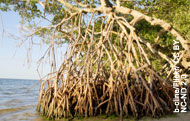 Why is this issue important?
Why is this issue important?
